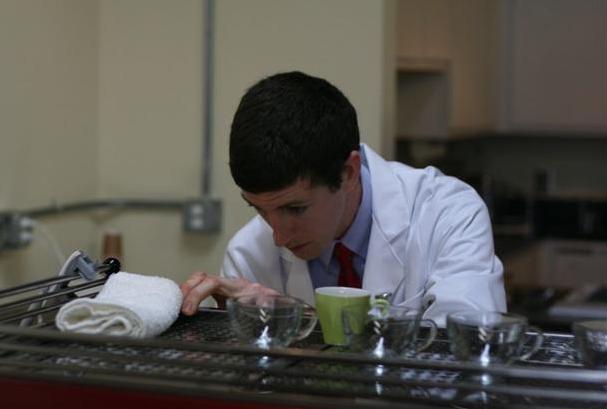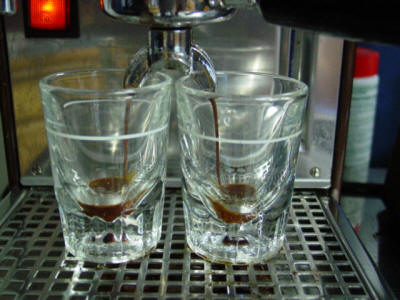I regularly find myself explaining to people about my experiences working at the most forward-thinking coffee shop in the city. To paraphrase my usual explanation: “Octane Coffee is dedicated to a continual evolution toward providing the best coffee possible by endlessly educating its employees and customers about the many facets of coffee cultivation, production, and preparation.” This education is founded on both technical training and technical knowledge of coffee. I’ve done an extensive amount of exploring through my exposure to the coffee world. Several of these experiences are documented here.
 Pulling two shots during my barista certification. Photo by John Cole.
Working so closely with our coffee roaster, Counter Culture Coffee (CCC), I have endless access to their training center and training instructors here in Atlanta. They regularly offer day-long training sessions covering all aspects of coffee preparation and production, which are structured in a lab atmosphere with equal parts lecturing and hands-on demonstrations.
Pulling two shots during my barista certification. Photo by John Cole.
Working so closely with our coffee roaster, Counter Culture Coffee (CCC), I have endless access to their training center and training instructors here in Atlanta. They regularly offer day-long training sessions covering all aspects of coffee preparation and production, which are structured in a lab atmosphere with equal parts lecturing and hands-on demonstrations.
I have completed both the SCAA created Brewing Lab and Milk Chemistry lab developed by Chris Owens of CCC. The Brewing Lab evaluates coffee brewing as a mass transfer problem where varying levels of coffee-to-water ratio, contact time, particulate size, water temperature, and mixture turbulence affect solubles concentration (“strength”) and solubles yield (“extraction”) in the final drink. The Milk Chemistry Lab treats milk steaming as a heat transfer and chemistry problem where protein strands in the milk fat are aerated at varying temperatures causing elongation and formation of air bubbles. The concentration and size of air bubbles then affect the perceived sweetness and texture of the milk.
Additionally, we have recently added a PID controller to the espresso boiler. To the average barista the addition of the PID is only a simple tool to help prepare better espresso by maintaining a very exact water temperature critical to extracting all the oils from the coffee without burning the grounds. But for me, the PID is a great insertion of my existing interests and engineering coursework into my current job. I’ve been excited in talking with Chris Owens and Curt (the two installers) about the varying gains in the control algorithm and their thought process for adjusting them. In the previous setup, the boiler thermostat acted as a simple on-off controller. Now, however, the boiler is controlled by a PID controller. One limitation of the current system that I find of particular interest is that there is no control over the decay (i.e. cooling of the boiler). If the boiler overshoots the desired 200 °F, only its Newtonian cooling can bring the system to equilibrium. As such, the derivative gain must be sufficiently high to limit overshoot, perhaps even high enough to over damp the system such that no overshoot occurs. However, from my personal observations, this is not the case as the system sometimes read temperatures of 201 or 202 °F.
The largest and most important aspect of my endeavors have come from training and preparing for my barista certification, a three stage process designed by Octane’s M’lissa Muckerman. The examination is comprised of three sub exams testing my craft, general knowledge, and combining both in a mock barista competition.
While the first part of the examination tested my ability to repeat several tasks flawlessly every time, the second and third phases really challenged my analytical skills. The second phase consisted of a written examination testing everything from espresso production, machine cleaning, coffee origins, and other parameters.
The final stage of the examination was a half-scale mock barista competition. In a professional setting, I had to prepare an espresso, a cappuccino, and a signature beverage of my creation for each of two sensory judges, while a technical judge and head judge oversaw my execution from setup to clean up. For my competition I was judged by sensory judges Ben Helfen and David LaMont, technical judge Chris Owens, and head judge M’lissa Muckerman.
The theme of my presentation was “Hello, and welcome to my shop, Octane Coffee.” I treated the entire event as an introduction to the novice, first-time customer. My entire monologue is amended below.
The competition requires that I prepare a 1 oz. espresso for each sensory judge (so 2 oz. total.) In a normal competition where the barista must serve four judges (make 4 oz. of espresso), he/she almost always chooses to create those four drinks from two portafilters. In other words, create two drinks from one portafilter by placing his/her cups such that 1/2 of the liquid is captured in each cup. Like this example:

This procedure, however, requires that the barista create a specific set of preparation variables: particle size(grinder setting) and amount of dry coffee (grams) in order to pass 2 oz. of water through the portafilter while maintaining a quality tasting drink. Unfortunately for me, these variables would be different from how we prepare espresso at Octane where we use 18 – 19 grams of coffee to create a 1 – 1.5 oz drink. Some of my co-barista who had already completed their competition produced 2 oz. of espresso from one portafilter by using more coffee (~21 grams) and a coarser grinder setting. While they achieved well-tasting results, I was having a hard time justifying a similar approach.
In my training sessions I quickly realized that I could make two drinks from two portafilters. This was something I’d been perfecting every day at Octane. I could simply prepare espresso the same way I was already doing it at Octane, which would fit perfectly into my theme of being an ambassador of Octane Coffee. I wanted to provide additional justification as to why “two drinks, one portafilter” would not produce the same results as “two drinks, two portafilters.” I spent some time reviewing Jim Schulman’s research and created a poster board detailing the numerical differences between the two methods. Ultimately, I realized that by using the “two drinks, one portafilter” method there was no way to achieve identical yield and concentration levels to the Octane method.
In the end, all of my practice and preparation paid off. I passed the competition by two points and, if not for a time overage, I would have had one of the highest scores of any of the eleven Octane Certified Barista! According to M’lissa, I had the second highest technical score! Two lessons learned that I’d pass on to any competing barista is that, if your time is running out and you have to decide between losing points for an unclean work area or losing points for running over in time, choose to lose points for not cleaning up =P. Also, make sure you actually turn on the espresso machine when you hit the button.
Finally, thank you to everyone who has been an “enabler of my coffee shop lifestyle”. You have all helped me to achieve something special.
Competition Monologue:
Hello, Thanks for coming today. My name is Jason Atwood and I work at Octane Coffee and today I’m going to talk today about what we do at our shop and about our ideas on coffee. I’m going to make you three drinks today that represent the range of coffee drinks that we offer at our shop. I’m going to start by preparing you each an espresso, followed up by cappuccinos, and finishing off with a drink which I created that highlights our brew coffee. In all three of these drinks I am going to use our Espresso Toscano by Counter Culture Coffee in Durham, North Carolina. The Toscano is a blend of Ipanema “Dulce” coffee from Brazil, Gayo from Aceh, Sumatra, and a third coffee from Lintong, Sumatra. We use this coffee because it is very easy to work with and it is a great espresso to get people interested in drinking good coffee. Its super smooth and had a great caramel taste. Its great in that it can both reward customers with a well trained pallet, and at the same time provide some great flavors for the novice coffee drinker. These factors are why we have chosen to use this coffee at our shop and why I’ve decided to use it here today. When it comes to preparation, we pull all of our espresso shots as ristrettos; we use more than standard amount of dry beans, brewed with less water, at a standard amount of time to result in a smaller portion of espresso. I’ll get into the specific math behind our espresso in just a second. The resulting drink is both more concentrated and has a higher yield than an standard espresso. This leads to extracting more of the sweet, caramelly flavors from the bean. The demonstration I’m presenting here today builds on the work of other coffee chemists, notably Jim Schulman and Andy Schecter. I’m also going to contrast my work with that of John Cole and Elizabeth Charrow, two of my fellow baristas at Octane. At our shop we prepare espresso by beginning with 18 grams of coffee and brewing it for 25 to 30 seconds producing 1 to 1.5 oz of espresso. In order to recreate this drink for you, others have tried to pull two shots from one portafilter. They’ve done this by adjusting their grind and notably their dosing methods to put as much as 21 grams of ground coffee into the portafilter. This method has both an effect on the concentration of the espresso (parts of espresso per thousand parts of water) and the solubles yield (percentage of the espresso extracted). However, as you can see here (point to board), maintaining the same concentration results in a different solubles yield or maintaining the same solubles yield results in a different concentration.